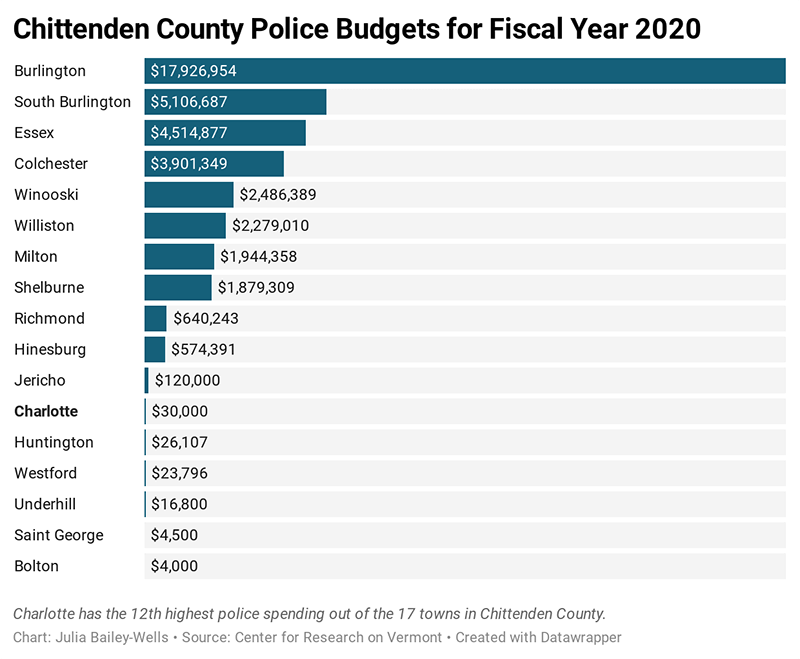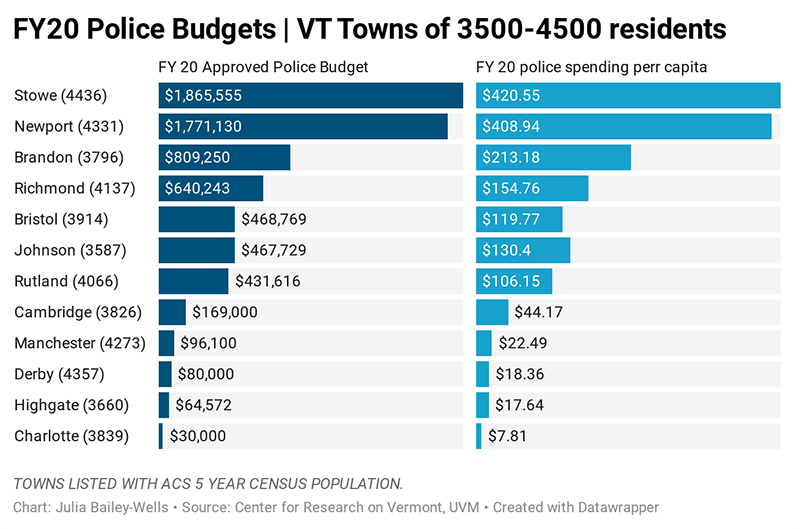Charlotte lowest per capita police spending in Chittenden County

 How much is Charlotte spending on policing? The simple answer: not a lot, but police services are a very small piece of the greater emergency services pie.
How much is Charlotte spending on policing? The simple answer: not a lot, but police services are a very small piece of the greater emergency services pie.
Charlotte utilizes the Vermont State Police as its primary police force, a service that is available to all municipalities in the state, but every municipality has the opportunity to create an additional local police force. This is contingent on their cooperation with the Vermont Mutual Aid Agreement for the Sharing of Municipal Resources. The purpose of this agreement is to ensure that every area of Vermont has access to all municipal services.
“The Legislature has allowed any municipality, any town or city the right to form their own municipal police force, which would add what they call the primary police force for that municipality. So currently, if a town or city does not have their own municipal police force, the state police are the de facto prime police service for that municipality. And that’s what Charlotte has,” explained Matt Krasnow, chair of the Charlotte Selectboard. The Town of Charlotte has contracted additional services to forge safer roadways by patrolling areas prone to speeding, accidents and criminal activity. This is where the $30,000 police budget goes, but that is just a fraction of the money spent on emergency services.
The Charlotte Town Budget for the last fiscal year appropriated $661,064 for the Charlotte Volunteer Fire and Rescue Service, more than 22 times what was appropriated for specific policing, but the mutual aid agreement works with all emergency services. So, while the Shelburne Police Department may be responding to police calls in Charlotte, CVFRS may be responding to ambulance calls in Shelburne.
“Cooperation of mutual aid also includes other emergency services, which I think is really important to look at. Or at least acknowledge emergency services is what we’re looking at from a community safety perspective. When there’s a car accident, it’s not just the police that responds, it’s the ambulance and the fire departments. So how are those services tied in to public safety? Policing is a hot button issue because social equity issues are really at the forefront of people’s consciousness, but it’s just a part of a much larger system,” Krasnow said. “It goes into the emergency services discussion, which I think policing is a large part of the mutual aid system…We are at a comfortable level with the level of police service that we have. From time to time I’ve heard residents wish that there was a faster response time. A municipal police force doesn’t guarantee that either.” Mutual Aid allows towns like Charlotte to focus their spending where it is essential.
Charlotte is among the lowest per capita in terms of police spending while towns such as Stowe and Newport spend more than $400 per citizen annually. Police spending in Vermont covers a wide range because of diverse communities across the state. Generally, the largest towns spend the most money on policing, with exceptions of towns that may have a smaller population but draw a lot of tourism, such as Stowe. Student researchers with the Legislative Intern Policy Center found that the average town police spending in Vermont is $176 per capita. Charlotte is one of ten towns with a population of more than 3,000 that spends less than $50 per capita on police services. Charlotte has the twelfth highest police budget out of the 16 towns that make up Chittenden County.
Chase McGuire is a student at the University of Vermont and participates in the Community News Group program, which provides local news written by student journalists to area media outlets.
